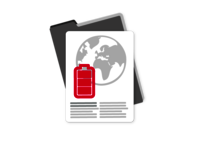In recent discussions, our customers repeatedly complain about their problems with the requirements of the various EU member states for the labelling of packaging material. Disposal labels, in particular, are considered to be “absolutely chaotic”. Each country does something different, has or is planning its own marking or, above all, tries to avoid confusion with packaging labels from other EU countries. Even those countries that implement relatively identical labelling requirements by law (e.g. Italy / Bulgaria) then get lost in different details (user instructions vs additional logos – Tidy Man).
The focus of the general discussion is on countries such as France (Triman), Italy, Bulgaria, Slovenia, Poland or Slovakia, but also on other countries that are planning implementation in the medium term.
One high rack for each and every country?
Globally positioned companies with complex supply chains frequently report problems. Environmental and compliance managers of companies trading on an international scale are considering the introduction of a separate high rack for each country in order to avoid merchandise being shipped to the wrong country.
Retailers do report an easing of problems with the ‘green dot’, as it has mostly been abolished or will be abolished in the foreseeable future, as in Spain, for instance. Other challenges arise instead, though. For instance, different packaging units are required to be labelled, which is ecologically questionable and makes relabelling even more complicated when selling to other countries. The templates for correct labelling of packaging are also a topic in themselves, as the example of Triman/France shows: The templates are only made available once the relevant applicant is registered there. If companies sell in France and their distributor is registered but they themselves are not, they cannot obtain the templates directly, which is highly complicated and can lead to re-sticking/oversticking or relabelling.
Is the uniform EU labelling coming?
According to the VERE Association, it is conceivable that the planned EU Packaging Regulation will also be followed up with a uniform logo or a European labelling regulation. This could lead to an exciting race between the French (Triman) and Italian / Bulgarian (alphanumeric codes) implementations.
Labelling of packaging is only a single aspect
This topic by far does not only concern the labelling of packaging or products, but also compliant information in the online store and in the instructions for use, e.g., CLP labelling, ecodesign labelling, energy efficiency label, CE mark, WEEE labelling, manufacturer information, UN 38.3 labelling of batteries or disposal labels (e.g. Triman, Mobius Loop, Tidyman, 97/129/EC, Sorting Information).
Assistance and advice in response to questions
Should you wish to register in the EU as a producer of WEEE, batteries, packaging, textiles or furniture, please do not hesitate to contact our Consulting Department via consulting@take-e-way.de or +49/40/750687-0.
For more in-depth advice on product labelling requirements, please contact us via sales@trade-e-bility.de +49/40/75068730-0.
For more information on our international compliance services related to the placing on the market of electronic equipment, batteries/accumulators and packaged products or packaging, please click here: https://www.take-e-way.com/international-compliance/

